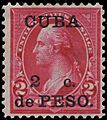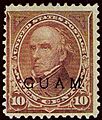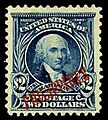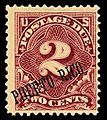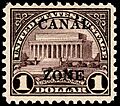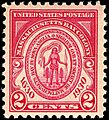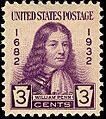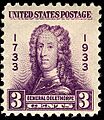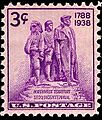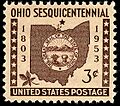Territories of the United States on stamps facts for kids
This article explores how different parts of the United States have been celebrated on postage stamps. These stamps show lands that became part of the U.S. through agreements, purchases, or after wars. Many states were formed from these lands. In fact, 31 states grew out of U.S. territories!
We'll look at stamps issued before 1978, as newer stamp images are protected by copyright. These stamps tell stories of how the U.S. grew, how people settled new areas, and how explorers discovered new places.
Contents
How the U.S. Grew: Changing Borders
The United States expanded its borders in many ways. Stamps help us remember these important moments in history.
Early Land Deals: Treaty of Paris
After the American Revolutionary War, Great Britain gave a lot of land to the U.S. in the Treaty of Paris in 1783. This land became known as the Northwest Territory and the Southwest Territory.
- Northwest Territory Stamp: A 3-cent stamp was released in 1937 to celebrate 150 years of the Northwest Territory. This area was north of the Ohio River and east of the Mississippi River. The stamp shows a map of the territory. It also features Manasseh Cutler and Rufus Putnam, who were important in setting up this new land. The Northwest Ordinance of 1787, which created this territory, also said that slavery was not allowed there.
- Mississippi Territory Stamp: In 1948, a 3-cent stamp marked 150 years of the Mississippi Territory. This stamp shows a map of what is now Mississippi and Alabama. It highlights how the territory grew over time. The stamp also features Winthrop Sargent, the first governor of the Mississippi Territory.
Big Expansions: Manifest Destiny
The idea of "Manifest Destiny" was that the U.S. was meant to expand across North America. This led to many new territories joining the country.
- Louisiana Purchase Stamps: The first big expansion happened in 1803 with the Louisiana Purchase. The U.S. bought this huge area from France. President Thomas Jefferson was key to this deal. A 1904 stamp shows his portrait. Another 1904 stamp features a map of the Louisiana Purchase area. In 1953, a stamp showed James Monroe, Robert R. Livingston, and François Barbé-Marbois signing the treaty.
- Florida and Texas Stamps:
- Florida Territory: In 1945, a 3-cent stamp celebrated 100 years of Florida becoming a state. It showed a map of the 1822 Florida Territory.
- Texas: Texas joined the U.S. in 1845. A 3-cent stamp in 1945 marked 100 years of Texas statehood. Texas had been its own republic after fighting for independence from Mexico. The decision to add Texas as a slave state led to the Mexican-American War.
- Mexican-American War and Land Acquisitions: The Mexican-American War (1846-1848) led to the U.S. gaining even more land.
- Kearny Expedition: A 3-cent stamp in 1946 honored the 100th anniversary of Colonel Stephen Watts Kearny's journey through New Mexico during the war. He helped establish American rule there.
- Mexican Cession: After the war, the Mexican Cession gave the U.S. a vast area stretching west to the Pacific Ocean. A 1937 stamp shows General Winfield Scott, a hero of this war.
- Oregon and Gadsden Purchase Stamps:
- Oregon Treaty: The U.S. and Great Britain settled their dispute over the Oregon Territory in 1846. A 3-cent stamp in 1936 celebrated 100 years of the Oregon Territory. It showed a map of the area, which included present-day Oregon, Washington, Idaho, and parts of Montana and Wyoming.
- Gadsden Purchase: In 1953, a 3-cent stamp marked 100 years since the U.S. bought the Gadsden Purchase from Mexico. This land became parts of Arizona and New Mexico. With this purchase, the main 48 states of the U.S. were complete!
- Alaska Purchase Stamps: The Alaska Purchase in 1867 was a huge deal. The U.S. bought Alaska from Russia for $8 million.
- Early Alaska Stamp: A 1909 stamp celebrated the Alaska-Yukon-Pacific Exposition. It honored the 1897 Klondike Gold Rush and 40 years since the Alaska Purchase. It features William H. Seward, who arranged the purchase. People first called it "Seward's Folly" (Seward's foolish act), but later realized how important it was.
- Alaska Airmail Stamp: A 1967 airmail stamp also commemorated the Alaska Purchase.
Island Territories: Insular Territories
The U.S. also acquired several island territories. The Postal Department issued stamps for Hawaii, Alaska, Puerto Rico, and the U.S. Virgin Islands in 1937.
- Hawaii and Alaska Stamps (1937):
- Hawaii: The stamp for Hawaii showed a statue of King Kamehameha I, who united the Hawaiian Islands. Hawaii became a U.S. territory in 1898.
- Alaska: The stamp for Alaska featured Mount McKinley (now Denali), with a farm and village. Both Alaska and Hawaii became states in 1959.
-
Kamehameha I Statue
Hawaii Territory -
Mount McKinley
Alaska Territory
- Puerto Rico and U.S. Virgin Islands Stamps (1937):
- Puerto Rico: This stamp showed 'La Fortaleza', a Spanish Governor's Palace. Puerto Rico became a U.S. territory after the Spanish-American War in 1898.
- U.S. Virgin Islands: This stamp displayed a view of Charlotte Amalie, the capital city. The U.S. bought these islands from Denmark in 1917.
-
La Fortaleza
Puerto Rico -
Charlotte Amalie
U.S. Virgin Islands
- Overprinted Stamps: Sometimes, the U.S. Postal Department used regular U.S. stamps but printed the territory's name over them, like "PUERTO RICO," "CUBA," "GUAM," "PHILIPPINES," or "CANAL ZONE." Cuba and the Philippines later became independent countries. The Canal Zone was returned to Panama.
- Panama Canal Stamps: The Panama Canal was a huge engineering project. It has been featured on many U.S. stamps. The Canal Zone was eventually returned to Panama.
- Pedro Miguel Locks: A 1913 stamp showed the Pedro Miguel Locks, part of the Panama Canal.
- Gaillard Cut: A 1939 stamp celebrated 25 years since the canal opened. It showed a steamship going through the Gaillard Cut. It also featured President Theodore Roosevelt, who pushed for the canal, and General George W. Goethals, the chief engineer.
Settling the Land: Filling in the Map
Stamps also tell the story of how people settled different parts of the U.S.
Settling the East
Many early settlements were along the East Coast.
- Jamestown Settlement: In 1907, a 2-cent stamp marked 300 years since the founding of Jamestown Settlement in Virginia. This was the first lasting British colony in America.
- New York and Massachusetts Settlements:
- Walloons in New York: A 1924 stamp celebrated 300 years since Walloons (Protestants from Belgium) settled in New York at Fort Orange.
- Massachusetts Bay Colony: A 1930 stamp marked 300 years of the Massachusetts Bay Colony. This colony was important for early American democracy.
- Plymouth Pilgrims: In 1970, a 6-cent stamp celebrated 350 years since the Pilgrims landed at Plymouth, Massachusetts.
- Founders of Colonies:
- William Penn: A 1932 stamp honored William Penn on the 250th anniversary of his arrival. He founded the colony of Pennsylvania.
- James Oglethorpe: In 1933, a 3-cent stamp honored James Oglethorpe on the 200th anniversary of his landing in Savannah, Georgia. He established the colony of Georgia.
- Roger Williams: A 1936 stamp marked 300 years since Roger Williams founded Providence, Rhode Island.
- Other Eastern Settlements:
- Connecticut Charter: A 1935 stamp celebrated 300 years of the Connecticut Charter of 1662.
- New York City: In 1953, a 3-cent stamp marked 300 years since New York City was founded as New Amsterdam.
- New Sweden: A 1938 stamp honored 300 years of the New Sweden colony in Delaware, founded by Swedes and Finns.
- Southern Colonial Settlements:
- Annapolis, Maryland: A 1949 stamp marked 300 years of settlement in Annapolis, Maryland.
- Carolina Charter: In 1963, a 5-cent stamp celebrated 300 years of the Province of Carolina Charter.
- Charlestown, South Carolina: A 1970 stamp marked 300 years since the settlement of Charlestown (Charleston).
- Early Statehood and Settlements:
- Vermont: A 1927 stamp celebrated Vermont's independence in 1777. Vermont was not one of the original 13 colonies but became the 14th state.
- New Hampshire: A 1955 stamp marked 150 years since the discovery of the "Old Man of the Mountains" rock formation in New Hampshire.
- Kentucky: A 1974 stamp celebrated 200 years since the first settlement in Kentucky at Fort Harrod.
- Northwest Territory Settlements:
- Marietta, Ohio: A 1938 stamp celebrated 150 years of settlement in the Northwest Territory, with Marietta, Ohio, being the first permanent place.
- Indiana Territory: A 1950 stamp marked 150 years of the Indiana Territory. It features William Henry Harrison, the first governor.
- St. Augustine, Florida: A 1965 stamp celebrated 400 years of the San Agustín settlement. This was the first lasting European settlement in the New World.
Settling the West
After the Mississippi River, the U.S. continued to expand westward.
- Kansas, Nebraska, and Iowa Territories:
- Kansas Territory: A 1954 stamp marked 100 years of the Kansas Territory. It shows a wheat field and pioneers.
- Nebraska Territory: A 1954 stamp celebrated 100 years of the Nebraska Territory. It features "The Sower" statue from the Nebraska Capitol.
- Iowa Territory: A 1938 stamp commemorated the Iowa Territory, which included parts of Minnesota and the Dakotas.
- Western Forts and Pioneers:
- Fort Snelling: A 1970 stamp marked 150 years of Fort Snelling, Minnesota, which helped open the Northwest.
- Swedish Pioneers: A 1948 stamp celebrated 100 years of Swedish pioneers settling the American Midwest, including the Wisconsin Territory.
- Fort Kearny: A 1948 stamp marked 100 years of Fort Kearny, Nebraska, which helped speed up settlement in the Nebraska Territory.
- Oklahoma and Minnesota Territories:
- Cherokee Strip: A 1968 stamp marked 75 years since the "Cherokee Strip" land rush in the Oklahoma Territory.
- Five Civilized Tribes: A 1948 stamp honored 100 years of settlement by Native Americans of the Five Civilized Tribes in Oklahoma. This stamp recognized their progress after the difficult "Trail of Tears" journey.
- Minnesota Territory: A 1949 stamp marked 100 years of the Minnesota Territory. It shows a pioneer and a Red River ox cart, used by fur traders.
- Oregon, Utah, and Washington Territories:
- Oregon Territory: A 1948 stamp celebrated 100 years of the Oregon Territory. It shows a wagon on the Oregon Trail and important figures like John McLoughlin and Jason Lee.
- Utah Territory: A 1947 stamp shows settlers entering the Great Salt Lake valley. Mormons, led by Brigham Young, began settling here after the U.S. gained the land in the Mexican-American War.
- Washington Territory: A 1953 stamp marked 100 years of the Washington Territory. It shows a pioneer family looking over the land.
- California and Nevada Settlements:
- San Francisco Bay: A 1913 stamp depicted the Spanish discovery of San Francisco Bay.
- San Diego: A 1969 stamp celebrated 200 years of settlement in San Diego.
- Alta California: A 1977 stamp marked 200 years since the first civil settlement in Alta California at San Jose.
- California Gold Rush: A 1948 stamp celebrated 100 years since gold was discovered in California at Sutter's Mill. This led to the "rush of Argonauts" and rapid growth.
- Nevada Settlement: A 1951 stamp marked 100 years since the first permanent white settlement in Nevada.
- Nevada Silver Rush: A 1959 stamp celebrated 100 years of silver discovery in Virginia City, Nevada.
Becoming States: Statehood Celebrations
Many stamps celebrate when territories officially became U.S. states.
States That Were Never Territories
The original 13 states were British colonies before the American Revolutionary War. Their statehood was celebrated with a series of stamps from 1987 to 1990, marking 200 years since they approved the U.S. Constitution.
Some other states also became states without first being an "organized U.S. territory":
- Vermont (1791)
- Kentucky (1792)
- Maine (1820)
- Texas (1845)
- California (1850)
- West Virginia (1863)
- Vermont, Kentucky, and Maine Statehood:
- Vermont: A 1941 stamp celebrated 150 years of Vermont statehood.
- Kentucky: A 1942 stamp marked 150 years since Kentucky joined the Union. It shows Daniel Boone overlooking the Kentucky River.
- Maine: A 1970 stamp celebrated 150 years of Maine statehood, showing a lighthouse.
- Texas, California, and West Virginia Statehood:
- Texas: A 1945 stamp marked 100 years of Texas statehood.
- California: A 1950 stamp celebrated 100 years of California statehood. It shows a gold miner and pioneers.
- West Virginia: A 1963 stamp marked 100 years of West Virginia statehood, showing a map of the state.
Eastern States from Territories
Many states in the eastern U.S. were formed from territories.
- Tennessee and Ohio Statehood:
- Tennessee: A 1946 stamp celebrated 150 years of Tennessee statehood. It shows the State Capitol and portraits of Andrew Jackson and John Sevier.
- Ohio: A 1953 stamp marked 150 years of Ohio statehood. It features the state seal on a map.
- Indiana, Mississippi, and Illinois Statehood:
- Indiana: A 1966 stamp celebrated 150 years of Indiana joining the Union.
- Mississippi: A 1967 stamp marked 150 years of Mississippi statehood, featuring the magnolia flower.
- Illinois: A 1968 stamp celebrated 150 years of Illinois statehood, showing a farm scene.
- Alabama, Michigan, Florida, and Wisconsin Statehood:
- Alabama: A 1969 stamp celebrated 150 years of Alabama statehood, featuring the camellia flower and yellowhammer bird.
- Michigan: A 1935 stamp marked 100 years of Michigan joining the Union.
- Florida: A 1945 stamp celebrated 100 years of Florida statehood.
- Wisconsin: A 1948 stamp marked 100 years of Wisconsin statehood, showing the State Capitol.
Western States from Territories
Many states in the western U.S. also grew from territories.
- Louisiana, Missouri, and Arkansas Statehood:
- Louisiana: A 1962 stamp celebrated 150 years of Louisiana statehood, showing a riverboat.
- Missouri: A 1971 stamp marked 150 years of Missouri statehood. It shows a scene of Native Americans and settlers.
- Arkansas: A 1936 stamp celebrated 100 years of Arkansas statehood, showing the Old State House.
- Iowa and Minnesota Statehood:
- Iowa: A 1946 stamp marked 100 years of Iowa statehood, showing the state flag and corn stalks.
- Minnesota: A 1958 stamp celebrated 100 years of Minnesota statehood, highlighting its lakes and hills.
- Oregon, Kansas, Nevada, Nebraska, and Colorado Statehood:
- Oregon: A 1959 stamp celebrated Oregon statehood, showing a covered wagon and Mount Hood.
- Kansas: A 1961 stamp marked 100 years of Kansas statehood, featuring a sunflower and pioneers.
- Nevada: A 1964 stamp celebrated 100 years of Nevada statehood, showing Carson City.
- Nebraska: A 1967 stamp marked 100 years of Nebraska statehood, featuring a Hereford cow and an ear of corn.
- Colorado: A 1951 stamp celebrated 75 years of Colorado statehood, showing the capitol building and the state flower.
- North Dakota, South Dakota, Montana, Washington, Idaho, and Wyoming Statehood:
- Four States (1939): A 1939 stamp celebrated 50 years of statehood for North Dakota, South Dakota, Montana, and Washington. It shows a map of these states.
- Idaho: A 1940 stamp marked 50 years of Idaho statehood, showing the State Capitol.
- Wyoming: A 1940 stamp celebrated 50 years of Wyoming statehood, showing the state seal.
- Oklahoma, New Mexico, Arizona, Alaska, and Hawaii Statehood:
- Oklahoma: A 1957 stamp marked 50 years of Oklahoma statehood, with the slogan "arrows to atoms."
- New Mexico: A 1962 stamp celebrated 50 years of New Mexico statehood, featuring "Shiprock" mesa.
- Arizona: A 1962 stamp marked 50 years of Arizona statehood, showing a saguaro cactus.
- Alaska: A 1959 airmail stamp celebrated Alaska statehood. It shows the state flag's stars on a map.
- Hawaii: A 1959 airmail stamp celebrated Hawaii statehood. It pictures a Hawaiian warrior and a star on a map of the islands.
Brave Explorers: Discovering New Lands
Stamps also honor the explorers who first ventured into these new lands.
- Early European Explorers:
- Christopher Columbus: He was honored on the first U.S. commemorative stamps in 1893. His voyages made the Americas known in Europe.
- Leif Erikson: This 11th-century Norse explorer was honored on a 1968 stamp.
- Vasco Núñez de Balboa: This Spanish explorer of the Panama Canal region was honored on a 1913 stamp. He was the first European to see the Pacific Ocean from the American continent.
-
Christopher Columbus, Caribbean
1893 issue -
Leif Erikson, Vineland
1968 issue -
Vasco Núñez de Balboa, Panama Isthmus
1913 issue
- French Explorers:
- Antoine de la Mothe Cadillac: A 1951 stamp honored him on the 250th anniversary of his landing in Detroit in 1701. He founded the city of Detroit.
- Jacques Marquette: He was honored on a 1898 stamp for exploring the Mississippi River. A 1968 stamp also honored him for establishing a settlement in Sault Sainte Marie, Michigan.
- Jean Nicolet: A 1934 stamp celebrated 300 years since his landing at Green Bay, Wisconsin, in 1634.
-
Antoine de la Mothe Cadillac, Detroit
1951 issue -
Jacques Marquette, Mississippi River
1898 issue -
Jacques Marquette, Sault Ste. Marie
1968 issue -
Jean Nicolet, Wisconsin
1934 issue
- English Explorers:
- John Smith: He was honored on a 1907 stamp for his role in the Jamestown settlement and exploring the Chesapeake region.
- Philip Carteret: A 1964 stamp honored him on New Jersey's 300th anniversary. He landed at Elizabethtown (Elizabeth), the state's oldest city.
-
John Smith, Virginia
1907 issue -
Philip Carteret, New Jersey
1964 issue
- Spanish Explorers:
- Francisco Vázquez de Coronado: He explored the Pacific Southwest for Spain. A 1935 stamp marked 400 years since his expedition. Another 1940 stamp also celebrated his explorations through the southwestern states.
-
Francisco Vázquez de Coronado, California
1935 issue -
Francisco Vázquez de Coronado
1940 issue
- American Explorers:
- Daniel Boone: This famous frontiersman was honored on a 1968 stamp. He was important in the development of Virginia, Kentucky, and the lands west of the Appalachian Mountains.
- Lewis and Clark: Captain Meriwether Lewis and Lieutenant William Clark led the Corps of Discovery to map the Pacific Northwest. A 1954 stamp celebrated 150 years of their expedition. They explored the vast lands of the Louisiana Purchase.
-
Daniel Boone, Virginia, Kentucky
1968 issue -
Lewis and Clark Expedition
1954 issue
- Later American Explorers:
- John C. Frémont: He was honored on a 1898 stamp. He was pictured placing the U.S. flag on a peak in the Rocky Mountains.
- John Wesley Powell: This geologist explored the Colorado River. A 1969 stamp honored him for his 1869 expedition down the Green and Colorado Rivers. He is considered the father of the U.S. Geological Survey.
-
John C. Frémont, Rockies
1898 issue -
John Wesley Powell, Green and Colorado Rivers
1968 issue





















